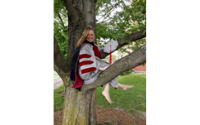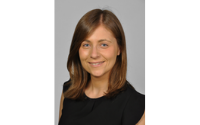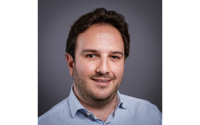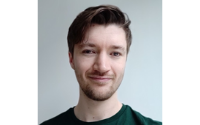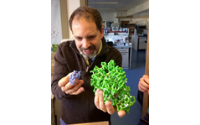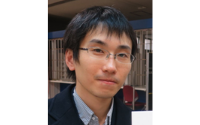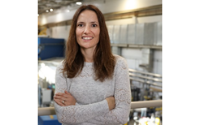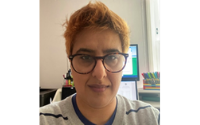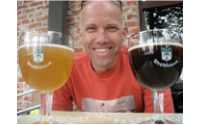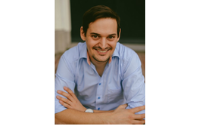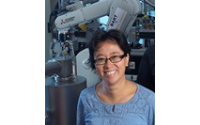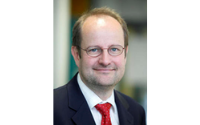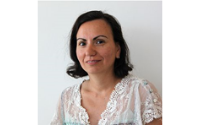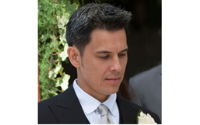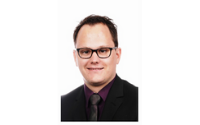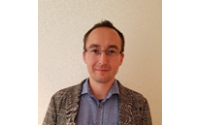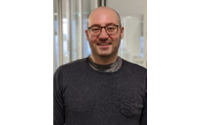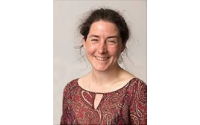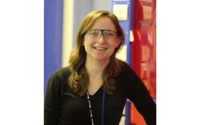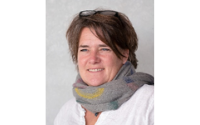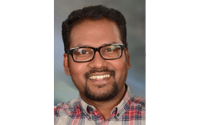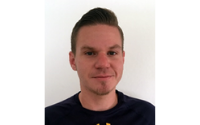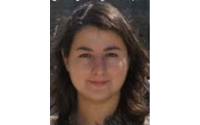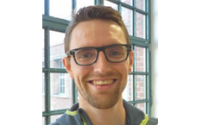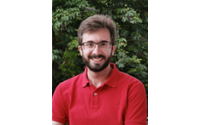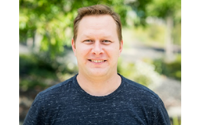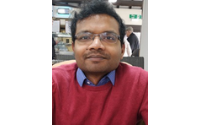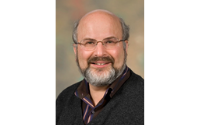Speakers
Here is more information about our Speakers scheduled for this event.
|
|
Dr Kelly Brock Institution: Harvard University Kelly is currently an Associate Research Director (previously a postdoc) in Debora Marks’ lab at Harvard Medical School, and is co-advised by Chris Sander. She spent her PhD studying the evolution of protein stress response in the England group at MIT. In her current work, she applies evolutionary couplings analysis both to predict protein structures de novo and to enable better fold and alternate conformation analysis from NMR and X-ray crystallography. She has a particular interest in understanding genotype-phenotype relationships in neurodegenerative disease. When not trying to bend computers to do her bidding, she enjoys playing pub trivia and playing with her 5-lb tiny dog, Frodo. |
|
|
Dr Joana Pereira Institution: Max Plank Institute Tübingen Joana Pereira was trained as a Biochemist at the University of Porto (Portugal) and received her PhD in Chemistry and Bioinformatics from the European Molecular Biology Laboratory (EMBL) and the University of Hamburg. There, she developed methods to improve the quality of protein models built with ARP/wARP, which resulted in the development of the protein backbone validation tool DipCheck. After graduating, she switch to protein evolution and protein sequence analysis and joined the group of Andrei Lupas at the Max Planck Institute for Developmental Biology in Tübingen. During the four years as a postdoctoral researcher in his Bioinformatics group, she studied the role of protein fragments in the emergence of a variety of folded protein domain families. Now, in January 2021, she is moving further south to join the group of Torsten Schwede at the Biozentrum in Basel, where she will collaborate on the development of SWISS-MODEL and explore the potentials hidden in hypothetical proteins. |
|
|
Dr Andrea Murachelli Institution: Netherlands Cancer Institute (NKI)
I started my career as a protein crystallographer, first with Andrea Musacchio and Thomas Schneider at at IFOM Milan, and then with Elena Conti at the Max Planck Institute in Martinsried for my PhD. Now, I am a senior postdoc in Titia Sixma's group at NKI Amsterdam, where I use cryoEM to study deubiquitinating complexes necessary for proper DNA damage repair. When away from the bench, I am responsible for the setup and maintenance of the GPU cluster that supports our department and our in-house microscope. Occasionally, I use python to write software that automates tedious tasks. Weblinks: https://www.nki.nl/people/murachelli-andrea/ |
|
|
Dr Airlie McCoy Institution: University of Cambridge My first degrees were in physics, mathematics and biochemistry at Adelaide, followed by my Honours degree with John Wallace studying insulin-like growth factors. I moved to Melbourne to do my PhD with Peter Colman in crystallography, studying single chain antibodies against influenza virus neuraminidase and the electrostatics of protein-protein interactions. A Royal Society Howard Florey fellowship then took me to Murray Stewart's lab at the MRC-LMB where I published structures of nuclear-cytoplasmic transport proteins, but I was drawn in by crystallographic methods. I stayed in Cambridge working on methods development, first briefly with Phil Evans and subsequently with Randy Read in the CIMR. Over the last 20 years we have developed maximum-likelihood and other methods to advance crystallographic phasing and have released them through our software Phaser. I speak regularly at the CCP4 study weekend and have previously also organised two. |
|
|
Dr Adam Simpkin Institution: University of Liverpool
During my PhD I focused on developing unconventional molecular replacement (MR) methods for solving the phase problem in crystallography. This included the development of AMPLE, a program that clusters and truncates cheaply obtained ab initio models from ROSETTA/QUARK and the development of SIMBAD, an online server and program distributed through CCP4, that uses a brute force approach to identify candidates for MR independently of sequence. As part of my PhD I spent two years at SOLEIL synchrotron where I also explored the use of anomalous phased Fourier maps to validate placed search models. During my Post-doc I have applied MR techniques to CryoEM using MRBUMP and I have taken on the development of MRPARSE, a program that tries to identify suitable search models for MR from both the PDB and online databases of ab initio models. |
|
|
Dr Pietro Roversi Institution: University of Leicester
Pietro worked on macromolecular refinement (Buster-TNT - now autoBUSTER) in the group of Dr. Gérard Bricogne in Cambridge 1995-2003, and went on to become a fully-fledged structural biology working with Prof. Susan Lea and Prof. Nicole Zitzmann in Oxford (2003-2012 and 2013-2018). He now holds a Wellcome Trust ISSF and LISCB Fellowship at the Leicester Institute of Chemical and Structural Biology and is a Lecturer in Natural Sciences at the University of Leicester. He studies ER glycoprotein folding quality control and degradation (ERQC and ERAD). Weblinks: https://le.ac.uk/liscb/research-groups/pietro-roversi |
|
|
Dr Keitaro Yamashita Institution: MRC Laboratory of Molecular Biology
Keitaro Yamashita received his PhD in Life Science from Hokkaido University in 2013. He has worked for software development for data processing and structure refinement in X-ray/electron crystallography and single particle analysis. He worked in RIKEN/SPring-8 Center and the University of Tokyo before joining Garib Murshudov's group in 2020. |
|
|
Dr Rob Nicholls Institution: MRC Laboratory of Molecular Biology
Originally from a background in mathematics and statistics, Rob is an active member of the computational crystallography development community. Particular interests include structure analysis and the use of prior knowledge in model building, refinement and validation, for both crystallography and cryo-EM. He is the lead author of ProSMART, and has been involved in multiple other developments including tools for low-resolution model refinement with REFMAC5. More recent research interests include the analysis of ligands and covalent linkages. Having contributed software to both CCP4 and CCP-EM suites, he has also been involved in the development of various GUIs to facilitate practical application. |
|
|
Dr Flora Meilleur Institution: Oak Ridge National Laboratory
Dr. Meilleur is a structural biologist specializing in protein chemistry and neutron crystallography, in the Department of Molecular and Structural Biochemistry, NC State, Raleigh and in the Neutron Scattering Division, Oak Ridge National Laboratory (ORNL), Oak Ridge. Dr Meilleur received her PhD in biophysics from the European Molecular Biology Laboratory (EMBL) and Université Grenoble Alpes (Grenoble, France) in 2004. She then served as instrument scientist on the LADI diffractometer at the Institut Laue Langevin (ILL), Grenoble. She moved to ORNL in 2005 and has held a joint faculty appointment with the Biochemistry department of NC State University since 2007. At ORNL’s High Flux Isotope Reactor she lead the construction of the single crystal diffractometer instrument IMAGINE. She currently supports and collaborates with users to elucidate enzymatic mechanisms using IMAGINE and the MaNDI instrument at ORNL’s Neutron Spallation Source. Her own research focuses lytic polysaccharide monooxygenases. She combines X-ray and neutron crystallography and DFT calculations to study the chemistry carried out by these redox enzymes. Weblinks: https://www.ornl.gov/staff-profile/flora-meilleur |
|
|
Dr David Waterman Institution: UKRI-STFC CCP4
David has a background in physics, but was drawn into structural biology as a postgraduate at the University of York. He completed a PhD on the structures of prokaryotic RNA-binding proteins, jumping in at the deep end to learn biology and chemistry on the job. He found this very rewarding, but nevertheless preferred computational work to the time he spent in the wet lab. In 2007 he started work as a postdoc at the newly opened Diamond Light Source. There he built up his programming skills and found a deeper appreciation for statistics as he worked with Gwyndaf Evans on simulating properties of X-ray detectors. It felt a natural step in 2011 to move over the road to the CCP4 core team based at the Research Complex at Harwell. He has remained in the CCP4 team since then, always working in close collaboration with Diamond on developing the DIALS software and on related projects. His main drive is to tackle interesting problems by experiment, computation and modelling. In recent years he has looked beyond X-ray crystallography to see what can be learned from crystallographic experiments using electrons and neutrons. Weblinks: https://www.scd.stfc.ac.uk/Pages/David-Waterman.aspx |
|
|
Prof Syma Khalid Institution: University of Southampton
Syma is professor of computational biophysics at the University of Southampton. Her research interests are centred around the dynamics of biomolecules in and around biological membranes with a particular focus on bacterial membranes and membrane proteins in nanotechnology. She uses molecular modelling and simulation at multiple levels of resolution to carry out her research. Syma’s work in recent years has sought to move away from a reductionist approach to adding the biochemical complexity of the bacterial systems she studies – developing the virtual bacterial cell envelope is one of her goals. Syma has authored over 70 peer-reviewed papers and book chapters. She is chair of HECBiosim. She serves on the management group that leads CCPBiosim and on the management committee of the British Biophysical Society. Syma has just been appointed to the EPSRC SAT in e-infrastructure and is on the steering group for the ExCALIBUR project which aims to get the UK ready for exascale computing in terms of software. She has recently joined the Rosalind Franklin Institute Advisory Team for the Artificial Intelligence and Informatics theme. Weblinks: https://www.southampton.ac.uk/chemistry/research/staff/sk2x07.page |
|
|
Dr Stephen Muench Institution: University of Leeds
Dr Stephen Muench is an Associate Professor in membrane biology at the University of Leeds. His group primarily use Electron Microscopy (EM) to study the structure and mechanism of proteins and protein complexes, with a special interest in membrane proteins. His work covers a wide range of systems from ion channels to antimicrobial targets. His group are developing a range of new approaches to studying membrane proteins from new scaffolds including styrene maleic acid copolymers (SMALPs) and new approaches to sample preparation. This includes the development of apparatus to rapidly mix and freeze specimens to permit time-resolved experiments by cryo-EM in the low ms range. Weblinks: https://biologicalsciences.leeds.ac.uk/school-biomedical-sciences/staff/116/dr-stephen-muench |
|
|
Dr Frans Mulder Institution: Aarhus University
Dr. Frans A.A. Mulder is Associate Professor of Biological NMR at the Interdisciplinary Nanoscience Center (iNANO) and Department of Chemistry, Aarhus University, Denmark. Frans is passionate about forging methodological advances in NMR spectroscopy and applies these methods to the study of biological systems involving metabolites, proteins and cells. His research may be considered as physical biochemistry, and Frans has made many innovative contributions to the study of protein structure, dynamics, electrostatics and interactions. Weblinks: https://pure.au.dk/portal/en/persons/frans-aa-mulder(0c10dd89-6182-482f-9c80-6739f9c9cbb8).html |
|
|
Dr Nick Pearce Institution: Vrije Universiteit Amsterdam
Nicholas Pearce (he/him) is a post doctoral researcher and Veni Laureate currently working at the Vrije Universiteit Amsterdam (Free University Amsterdam). He gained his PhD from the University of Oxford in 2017. He works on developing novel structural-analysis and structure-determination methods within macromolecular X-ray crystallography and cryo-EM. His previous work includes approaches for identifying weakly-binding partial-occupancy ligands (PanDDA), and methods for modelling, refining and validating multi-state superpositions. His current work focusses on disorder modelling in macromolecular structures, and the extraction of flexibility information from this macromolecular disorder. Weblinks: https://research.vu.nl/en/persons/nick-pearce |
|
|
Prof Silvio Tosatto Institution: University of Padua
Weblinks: https://protein.bio.unipd.it/people/silvio |
|
|
Dr Alice Douangamath Institution: Diamond Light Source
I studied Physics at the University Paris 7 (France) and completed a joint PhD (University Orsay, France and EMBL-Hamburg, Germany) in biophysical characterisation of protein interactions. I then moved to the pharmaceutical industry (Morphochem, Switzerland and Evotec Ltd, UK) where, as a crystallographer, I was involved in structure-based drug discovery projects. In 2007, I joined Diamond Light Source for the construction of the high-throughput beamline i04-1 and continued on with the development of the XChem platform. Since 2018, I am responsible for the XChem facility and its user program. Weblinks: https://www.diamond.ac.uk/Instruments/Mx/I04-1/Staff/Douangamath.html |
|
|
Prof Harald Schwalbe Institution: Goethe University Frankfurt
Our group is interested in the determination of structure and dynamics of a variety of molecules of chemical and biological interest, organic synthesis of biologically relevant compounds and nmr method development. This includes natural and nonnatural biomacromolecules: Proteins in their folded and unfolded state, oligonucleotides like RNA and DNA and their complexes, and nonnatural biopolymers. While many of our projects involve the use and development of new methods in high resolution NMR-spectroscopy of liquids as a major technique, our group is engaged in the chemical and biochemical synthesis of proteins, RNA and DNA as well as photolabile cage compounds. Many of the research projects are collaborative in nature, and we have a wide range of interactions with other academic research groups. Weblinks: http://schwalbe.org.chemie.uni-frankfurt.de/group_members/principal-investigator/harald-schwalbe
|
|
|
Dr Mathew Martin Institution: Newcastle University
Mat’s research is focused at the interface between chemistry and cell biology, using biophysical and biochemical techniques to aid characterisation of small molecule inhibitors of proteins, and protein-protein complexes. This cell-free characterisation plays a central role in drug discovery, expediting the preclinical phases from hit finding to lead optimisation. It also accelerates the discovery of high-quality probe molecules for target validation and biomarker discovery. Mat joined the Cancer Research UK Newcastle Drug Discovery Unit in 2013 and oversees the activities of the protein science component of the DDU led by Prof. Martin Noble. Before this he spent four years at Moffitt Cancer Center in the laboratory of Prof. Ernst Schonbrunn, after completing his Ph.D at the University of Exeter with Prof. Jenny Littlechild. Mat has been involved in a number of drug discovery projects, targeting multiple classes of clinically relevant proteins, encompassing a range of disease areas. His application of rational drug design has led to lead inhibitors that have advanced into cellular and animal studies, alongside a number of publications. >1100 citation and i10 index -21. Weblinks: https://www.ncl.ac.uk/medical-sciences/people/profile/mathewmartin.html |
|
|
Dr Maria Garcia Alai Institution: EMBL Hamburg
Team leader at EMBL HH and Head of EMBL SPC Facility. Facility head (HTX & PC) at the CSSB (Centre for Structure Systems Biology). The Garcia-Alai team at EMBL Hamburg develops methods for sample optimisation and characterisation for SAXS, MX and EM experiments and applies systematic pipelines of biophysical techniques to solve dynamic structural puzzles, with particular focus on protein-lipid interactions occurring during endocytosis and other membrane remodeling processes. Weblinks: https://www.embl-hamburg.de/research/unit/garcia-alai/members/index.php?s_personId=CP-60018450
|
|
|
Prof Hugo van Ingen Institution: Utrecht University
Hugo van Ingen obtained his PhD in biomolecular NMR in 2006 from the Radboud University, working under supervision of prof. dr. Geerten Vuister. He then did postdoctoral studies at Utrecht UNiversity with prof. dr. Rolf Boelens and at Toronto University with prof. dr. Lewis Kay, where he was trained in the NRM approaches for high-molecular weight systems and started to wrok on the nucleosome. With help of Veni and Vidi grants he started his independent research, and after a period at Leiden University, rejoined Utrecht University in 2017 as assistant professor to lead the solution NMR efforts. Weblinks: https://www.uu.nl/staff/HvanIngen |
|
|
Dr Rob Rambo Institution: Diamond Light Source
Weblinks: https://www.diamond.ac.uk/Instruments/Soft-Condensed-Matter/small-angle/B21/Staff/Robert-Rambo.html |
|
|
Dr Patrick Rabe Institution: University of Oxford
Weblinks: http://schofield.chem.ox.ac.uk/patrick-rabe.aspx |
|
|
Dr Przemek Nogly Institution: ETH Zurich Przemek Nogly is a group leader at the Swiss Federal Institute of Technology in Zurich. His research is focused on the structural dynamics of transport proteins and photoreceptors. He was awarded an Ambizione career development grant by the Swiss National Science Foundation to study the molecular mechanism of transport in a chloride pumping rhodopsin. Weblinks: https://noglygroup.ethz.ch/ |
|
|
Dr Pedram Mehrabi Institution: Max Planck Institute for the Structure & Dynamics of Matter
Pedram earned his bachelors at the University of Waterloo in Canada, and his Masters at York University. Pedram completed his PhD at the University of Toronto in the field of structural biology, specifically in the fields of both classical and time-resolved x-ray crystallography. Upon being awarded an Alexander von Humboldt fellowship he moved to Hamburg to continue as a postdoc at the Max Planck institute for the structure and dynamics of Matter focusing almost exclusively on method development for time-resolved approaches. He will continue this research as an Emmy Noether fellow in 2021. Weblinks: https://www.mpsd.mpg.de/person/54800/2736 |
|
|
Dr Arwen Pearson Institution: Center for Free-Election Laster Science - CFEL
Professor of Experimental Biophysics at Universität Hamburg and co-leader of the T-REXX endstation for time-resolved structural biology on P14 at PETRA III. Weblinks: www1.physik.uni-hamburg.de/en/inf/ag-pearson.html |
|
|
Dr Diana Monteiro Institution: Hauptman-Woodward Medical Research Institute
I obtained my PhD in Structural Biology from the Astbury Centre (University of Leeds, UK) focusing on the development of photochemical tools for protein triggering in time-resolved experiments. During this time, I also investigated a novel negative feedback mechanism in the bacterial pantothenate biosynthetic pathway. I then moved into the field of microfluidics on a Louise Johnson Fellowship with the Centre for Ultrafast Imaging (Universität Hamburg, DE). The microfluidics were designed to yield novel platforms for the collection of serial synchrotron and XFEL data (SSX, SFX) on protein micro crystals. As part of a highly collaborative team, we demonstrated the use of photo-decaging and stop-flow to determine conformational changes of membrane proteins by time-resolved SAXS. Recently, I started my own research group at the Hauptman-Woodward Institute (Buffalo, NY, USA). We are a hybrid lab, developing chemical tools to address complex biological problems, including photocaged molecules for time-resolved studies of membrane bound receptors and peptides to modulate protein activity. Weblinks: https://hwi.buffalo.edu/scientist-directory/diana-monteiro/ |
|
|
Prof Birthe Kragelund Institution: University of Copenhagen
Birthe B. Kragelund is professor in protein biophysics and NMR spectroscopy, in the Linderstrøm-Lang Centre for Protein Science at the Department of Biology, University of Copenhagen, Denmark (DK). She did her PhD in protein folding at the Carlsberg Laboratory, DK and at Oxford University, UK, took a post doc in Lund, Sweden, in structural biology and biomolecular NMR, and returned to Denmark to the University of Copenhagen. Here she embarked on integrative structural biology with a strong focus on the roles and mechanisms of intrinsically disordered proteins in biology, using in particular NMR spectroscopy and other biophysical tools. Current research is centred on protein intrinsic disorder in biology, cytokine receptor activation and membrane transporters and understanding the correlation between protein intrinsic disorder and protein function, including new mechanisms of actions. Weblinks: https://www1.bio.ku.dk/english/research/bms/research/sbinlab/groups/bbk/ |
|
|
Dr AA Jeyaprakash Institution: The University of Edinburgh
Jeyaprakash is a Wellcome Senior Research Fellow at the Wellcome Centre for Cell Biology (WCCB), University of Edinburgh, UK. JP, as he is known among his colleagues and peers, completed his PhD in 2004 at the Indian Institute of Science, Bangalore with Prof. M. Vijayan. His PhD work concerned the understanding of molecular determinants of carbohydrate specificities of plant lectins. After his PhD, JP obtained Alexander von Humboldt and Marie-Curie Fellowships to work with Elena Conti at EMBL-Heidelberg and subsequently at the Max-Planck Institute of Biochemistry, Martinsried, Germany, where he got interested in understanding the molecular mechanisms of accurate cell division. After a successful postdoctoral research JP received a Wellcome Career Development fellowship to start his independent research group at the WCCB in 2012. Since 2017, he is a Wellcome Senior Research Fellow. JP’s lab is interested in understanding the structural level mechanistic details of processes regulating chromosome segregation during cell division. Weblinks: https://www.wcb.ed.ac.uk/research/arulanandam |
|
|
Dr Dina Schneidman Institution: Hebrew University of Jerusalem
Dina Schneidman is an assistant professor in the Computer Science and Engineering School and Department of Biochemistry at the Institute of Life Sciences at the Hebrew University of Jerusalem. Her interdisciplinary research focuses on development and application of computational methods for modeling structure and dynamics of macromolecular assemblies integrating information from diverse sources. Dina Schneidman received her PhD in 2008 under supervision of Profs. Haim Wolfson and Ruth Nussinov at Tel Aviv University developing methods for structural modeling of protein-protein interactions. One of these methods, PatchDock for rigid protein-protein docking, is among the most efficient methods widely used to this day. During post doctoral research in Andrej Sali lab at the University of California, San Francisco, she developed and applied computational methods for Integrative Structure Determination using multiple information sources, including small angle X-ray scattering (SAXS), electron microscopy (EM), NMR spectroscopy, and cross-linking detected by mass-spectrometry (XLMS). Methods for modeling with SAXS profiles have already become standard tools among SAXS users due to their accuracy, speed, and user-friendly interface. |
|
|
Dr Brinda Vallat Institution: RCSB PDB
Dr. Brinda Vallat is an Assistant Research Professor at the Institute for Quantitative Biomedicine at Rutgers, the State University of New Jersey. She is a computational biologist by training and has previously worked on modeling and analysis of biomolecular structures. Her current research aims at building tools for data standardization, validation and archiving. Since 2015, she has been working with Drs. Helen Berman (Rutgers) and Andrej Sali (UCSF), to create the infrastructure for archiving integrative structures of biological macromolecules. |
|
|
Dr Daniel Serwas Institution: University of California, Berkeley Daniel Serwas is a Human Frontier Science Program (HSFP) postdoctoral fellow. He obtained his BSc from the University of Bonn, Germany and did his PhD at the Max Perutz Labs in Vienna, Austria. Since September 2017, Daniel has been an active member of the Drubin and Davies lab at the University of California, Berkeley, USA. His research interest focuses on understanding how cytoskeletal networks form and how they perform their versatile functions within cells. His current HSFP project focuses on understanding the mechanistic role of the actin cytoskeleton in clathrin-mediated endocytosis. To achieve this, Daniel is combining cryo-correlative light and electron microscopy, cryo-electron tomography and subtomogram averaging to study the structural organization of endocytic sites inside human cells. In collaboration with theoretician colleagues these detailed data are used to constrain mathematical models for actin function during clathrin-mediated endocytosis.
|
|
|
Dr Ana Perez-Berna Institution: ALBA
I started my scientific career at Universidad Miguel Hernandez (UMH, Elche, Spain), where I graduated in Biochemistry, being awarded as the most outstanding student in the degree. Immediately after my graduation, I started my PhD thesis at Institute for Molecular and Cellular Biology (IBMC) of UMH, where I developed my work on biophysics field, studying the mechanism of entry of different virus HCV, HIV and SARS into the cell. Also I spent 7 months at the IBNR of the Austrian Academy of Sciences (Graz, Austria). Finally, this thesis was awarded with the national prize Juan Abello Pascual and as the most outstanding thesis in the field of Biological Sciences. Thereafter, I moved to National Biotechnology Center (CNB-CSIC) in Madrid, in order to research in Adenovirus structure, which gave me the opportunity to broaden my knowledge on electron microscopy and structural virology. During my postdoc, I have applied techniques like tomography and subtomogram averaging, acquired during a 4-months stage the National Institutes of Health (Bethesda, MD, USA). Currently, I am beamline scientist in the ALBA synchrotron in the MISTRAL beamline, where I provide support at the users in the beamline and develop my scientific research in the field of virology in collaboration with CNB. MISTRAL performs full-field cryo soft X-ray tomography (cryo-SXT) in the water window photon energy range to investigate in whole and unstained cells in conditions close to the living physiological state. |
|
|
Dr Maria Harkiolaki Institution: Diamond Light Source
Maria is the Principle Beamline Scientist at the ccorrelative cryo-imaging beamline B24 at the UK synchrotron Diamond light Source. Previously she was a group leader at the Structural Biology Laboratory at the Nuffield Department of Medicine of the University of Oxford, UK. Maria undertook her graduate studies at York Structural Biology Laboratory at the University of York, UK, and was awarded her PhD in 2002. Weblinks: https://www.diamond.ac.uk/Instruments/Biological-Cryo-Imaging/B24/Staff/Harkiolaki.html |
|
|
Dr Francis O'Reilly Institution: Technische Universität Berlin
During my career, I have aspired to do structural biology in situ. As a postdoc in Juri Rappsilber’s lab I have developed mass crosslinking mass spectrometry, towards solving structures of complexes within cells. Recently, this technologyhas proven particularly powerful when applied to studying transcription and translation in bacterial cells in combination with cryo-electron tomography. |
|
|
Dr Enrico Luchinat Institution: University of Florence
Enrico Luchinat obtained his Bachelor Degree in Chemistry in 2007 and his Master Degree in Chemistry of Biological Molecules in 2009 at the University of Florence, Italy. In 2013, he obtained his International PhD degree in Mechanistic and Structural Systems Biology at the Magnetic Resonance Center (CERM) of the University of Florence. He is currently a senior post-doc at CERM, where he develops and applies in-cell NMR methodologies to monitor protein folding, maturation and chemical modifications, and protein-ligand interactions at atomic resolution in living human cells. |
|
|
Dr Robbie Joosten Institution: Netherlands Cancer Institute (NKI)
Robbie Joosten is a bioinformatician turned structural biologist and works at the Biochemistry department of the Netherlands Cancer Institute. His research interest is the quality of macromolecular structure models: "How good are they and can we make them any better?" Together with a small team, Robbie created and maintains the PDB-REDO framework (pdb-redo.eu) that addresses that question with new tools for model building, refinement, and validation. Weblinks: https://www.nki.nl/people/joosten-robbie/ |
|
|
Dr Oleg Sobolev Institution: The Lawrence Berkeley National Laboratory
I develop and implement computational methods for macromolecular biology for over 10 years. For the last 6 years I contribute to cctbx library and Phenix software suite. The most recent development is Rama-Z score performed in close collaboration with PDB-REDO team. This is essential validation metric especially for lower resolution models when Ramachandran restraints are often present during refinement. I have also developed tools and restraints for secondary structure both proteins and nucleic acids. I have introduced new type of geometrical restraints – parallelity used to handle stacking interactions in nucleic acids. Apart from that I oversee other lower-resolution restraints in Phenix such as NCS, Ramachandran, Reference model and others. Weblinks: https://biosciences.lbl.gov/profiles/oleg-sobolev/ |
|
|
Dr Agnel Joseph Institution: UKRI-STFC CCP-EM
Agnel has a PhD in structural bioinformatics and has been working on computational methods for cryoEM for about 8 years. He did a postdoc at Birkbeck College on computational methods for fitting and validation of atomic models. He is currently at STFC working with CCP-EM on aspects of cryo-EM model validation. Weblinks: https://www.scd.stfc.ac.uk/Pages/Agnel-Praveen-Joseph.aspx |
|
|
Dr Eugene Krissinel Institution: UKRI-STFC CCP4
Dr Krissinel leads the Core Group of CCP4, which is responsible for the maintenance, development and distribution of the CCP4 Software Suite in protein crystallography. In 2000-2009, Dr Krissinel worked in the PDBe (former Macromolecular Structure Database, MSD) at the European Bioinformatics Institute, UK, where he became known to the structural biology community for his works in the field of protein-protein interactions (PPI) and protein structure analysis. His software for the PPI and oligomeric state analysis and prediction (PISA), and protein structure alignment (SSM/Gesamt) are widely used and regarded as de-facto standard tools in the field. Before his career in structural bioinformatics and crystallography, Dr Krissinel worked on the theory of time-resolved diffusion and spin control in radical reactions, quantum kinetics (1997-2000 Humboldt Fellow, University of Konstanz, Germany, 1989-1995 Russian Academy of Sciences), and molecular dynamics of metallic alloy microclusters (1995-1997 Argonne National Laboratory, USA). Weblinks: https://www.scd.stfc.ac.uk/Pages/Eugene-Krissinel.aspx |
|
|
Dr Dima Kozakov Institute: Laufer Center for Physical and Quantitative Biology Dima Kozakov received an M.S. in Applied Mathematics and Physics in Moscow Institute of Physics and Technology, and PhD in Biomedical Engineering at Boston University. Currently he is Assistant Professor in the Department of Applied Mathematics at Stony Brook University, Affiliate Member at Laufer Center for Physical and Quantitative Biology, and Affiliate Member at Institute of Advance Computational Sciences. Before joining Stony Brook he held research faculty position at Boston University. Dr. Kozakov is interested in method development for modeling of biological macromolecules , with emphasis on molecular interactions and drug design. Dr. Kozakov’s protein-protein docking approach ClusPro has been consistently the best automatic approach in worldwide blind protein docking experiment CAPRI. Currently ClusPro has more than 20000 users, and have run around 200,000 jobs in the last few years. His docking tools are licensed by Schrodinger, largest pharmaceutical software vendor in the world, and are used by multiple major pharma worldwide. His research has been funded by the National Institute of Health (NIH), National Science Foundation (NSF), and Binational (US-Israel) Science Foundation (BSF).
|

